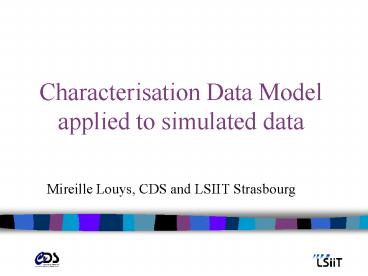Characterisation Data Model applied to simulated data PowerPoint PPT Presentation
1 / 13
Title: Characterisation Data Model applied to simulated data
1
Characterisation Data Modelapplied to simulated
data
- Mireille Louys, CDS and LSIIT Strasbourg
2
Characterisation metadata
- Should answer the question
- Where, when, what, how precise and reliable
are the data for one observation? - FoV, Bandpass, Resolution, Quantum Efficiency,
etc - It is a summary of metadata to be used for data
retrieval as in DAL protocols but also for data
analysis resampling, source detections,
multi-wavelength analysis, etc
3
Organising metadata
- Lists the properties of an observation
coverage, resolution , sampling precision,
sensitivity, point spread function, transmission
curve, etc - These are the quantitative information that we
can derive from the Provenance (acquisition or
simulation process). - Defines characterisation axes as space, time,
wavelength, observable which is the measured
quantity like flux, photons, counts, etc - Categorise them according to a unified framework
- ? Data model expansion capability
4
Physical Axis
Property of the data
Coverage
Resolution
Sampling
Level of description
5
UML model Properties Levels
6
Quality and Errors
- Each assessed property will have the required
value, unit, ucd fields plus an error on this
value. - The typical error on the data, that is the error
we make when we map sampling elements to
coordinates, is also needed . - E.g. astrometric error, photometric error, etc
- They will be attached to the axis on which the
mapping is done spatial, observable, etc - Valid for both systematic and statistical errors.
7
Axis description and mapping error
8
Categorising use-cases complexity (1)
- In terms of use cases
- Data discovery and selection level 1-2-3
- Multi regime, multi data type
- Xmatch of metadata to navigate between complex
datasets cubes, spectra, images, catalogs - ? Valid for both observed and simulated data
- Advanced data processing level 4
- Physical interpretation, recalibration
- Description of side products to help for data
interpretation - PSF variation, transmission curve, quality maps,
weightmaps, etc - ? Valid for fine comparison between observed and
simulated data
9
Characterisation model expansion
- In terms of data content
- More complex axes can be defined
- polarimetry, velocity, visibility
- More data properties can be added
- In terms of dependencies
- Coupling of characterisation axes
- expressed as functions
- e.g. Resolutionf(pos,em,time)
- expressed as variability maps, e.g. PSF
variations maps
10
PHENOMENON
PROVENANCE
DATA CHARACTERISATION
Scientific knowledge
11
PHENOMENON
PROVENANCE
CHARACTERISATION DM
Scientific knowledge
LEVEL 4
Interpretation metadata
Error maps
Observation Process
Object of interest
Input Data
Transmission curves Weighting functions PSF
variability
Proposal
Ambiant conditions
Filters
Instruments
Output Data
LEVELS 1-2-3
LEVEL 4
12
Simulated vs observed data commonalities and
differences
- They share axes, data properties, format (?),
coding. - spatial axis observed data are always centered
on real sky position, simulated data are not
necessarily. - Calibration information is extracted from the
Provenance information - Specific interpretation metadata can be generated
by the simulation computation. - Maps, multivariable functions to be described by
level4 classes in Characterisation.
13
Conclusion
- The Characterisation model can carry out the
description of simulation output data. - Version 1.0 currently to describe the top 3
levels the footprint of the data on the axes - The next version of the model will emphasize the
level 4 structures. - Simulation codes to be described
- DALIA, Frederic Boone, Obs. Paris, LERMA
- An homogeneous dynamical interface for various
simulation codes XML schema description - Compatible to workflows in data processing
- To be part of the Provenance DM effort?
- Need for Phenomenon modeling

